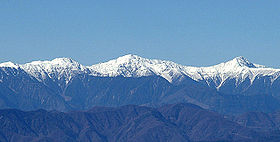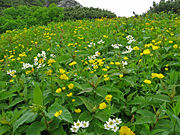
Mount Kita
Encyclopedia


Mountain
Image:Himalaya_annotated.jpg|thumb|right|The Himalayan mountain range with Mount Everestrect 58 14 160 49 Chomo Lonzorect 200 28 335 52 Makalurect 378 24 566 45 Mount Everestrect 188 581 920 656 Tibetan Plateaurect 250 406 340 427 Rong River...
in Japan
Japan
Japan is an island nation in East Asia. Located in the Pacific Ocean, it lies to the east of the Sea of Japan, China, North Korea, South Korea and Russia, stretching from the Sea of Okhotsk in the north to the East China Sea and Taiwan in the south...
, after Mount Fuji
Mount Fuji
is the highest mountain in Japan at . An active stratovolcano that last erupted in 1707–08, Mount Fuji lies about south-west of Tokyo, and can be seen from there on a clear day. Mount Fuji's exceptionally symmetrical cone is a well-known symbol of Japan and it is frequently depicted in art and...
, and is known as "the Leader of the Southern Alps". It is included in the 100 Famous Japanese Mountains. It is situated in the city of Minami-Alps, Yamanashi Prefecture
Yamanashi Prefecture
is a prefecture of Japan located in the Chūbu region of the island of Honshū. The capital is the city of Kōfu.-Pre-history to the 14th century:People have been living in the Yamanashi area for about 30,000 years...
, Japan
Japan
Japan is an island nation in East Asia. Located in the Pacific Ocean, it lies to the east of the Sea of Japan, China, North Korea, South Korea and Russia, stretching from the Sea of Okhotsk in the north to the East China Sea and Taiwan in the south...
. It is part of the Akaishi Mountains
Akaishi Mountains
is a mountain range in central Honshū, Japan, bordering Nagano, Yamanashi and Shizuoka prefectures. It is also called the , as it joins with the Hida Mountains and the Kiso Mountains to form the Japanese Alps....
, which are known as the "Southern Alps" (南アルプス Minami-Arupusu).
Geography
The is a 600 m (1,969 ft) tall rock face on the eastern side of the mountain.Alpine plant
Alpine plant
Alpine plants are plants that grow in the alpine climate, which occurs at high elevation and above the tree line. Alpine plants grow together as a plant community in alpine tundra.-Alpine plant diversity:...
s grow abundantly, especially on the mountain's southeastern slope along the route to and along the and courses along on the mountain's northern side. Large clusters of plants can be seen from huts near the top. The species is endemic to this mountain.
Origin of the name
The main mountains of the Akaishi Mountains are Mount Kita, Mount AinoMount Aino
, or Ainodake, is one of the 100 Famous Japanese Mountains. At , its peak lies in the Akaishi Mountains of Japan on the border of Aoi-ku, Shizuoka, Shizuoka Prefecture, and Minami-Alps, Yamanashi Prefecture...
and Mount Nōtori
Mount Notori
, or Nōtoridake, is one of the major peaks in the Akaishi Mountains, along with Mount Kita and Mount Aino. The peak lies to the south of the other mountains, spanning the town of Hayakawa in Yamanashi Prefecture and Aoi-ku in the city of Shizuoka, Shizuoka Prefecture, Japan.- Geography :The top of...
. The three mountains together are called , which means "Three White Summits". The name Mount Kita literally means "northern mountain," referring to its being the northernmost of the three mountains.
Climbing
The mountain area around Mount Kita is one of the most popular in Japan, reputedly second only to the Mount YariMount Yari
is one of the 100 Famous Japanese Mountains. The high peak lies in the southern part of the Hida Mountains of Japan, on the border of Ōmachi and Matsumoto in Nagano Prefecture and Takayama in Gifu Prefecture...
and Mount Hotaka
Mount Hotaka
, also known as Mount Hotakadake, is one of the 100 Famous Japanese Mountains, reaching a height of . It is situated in Japan's Hida Mountains and all its major peaks besides Mount Maehotaka, lie on the border between the cities of Matsumoto, Nagano Prefecture, and Takayama, Gifu Prefecture...
area. Access points for climbing
Climbing
Climbing is the activity of using one's hands and feet to ascend a steep object. It is done both for recreation and professionally, as part of activities such as maintenance of a structure, or military operations.Climbing activities include:* Bouldering: Ascending boulders or small...
are at to the east and to the west; however, most people choose to climb from Hirogawara, where facilities are better. Two mountain huts near the top provide accommodation for up to 150 people and there are campground facilities nearby.
There are three main access routes to the summit of Mount Kita. The first starts out in Hirogawara and follows the up through the . Another route leaves the river valley earlier and emerges from the forest at Shiraneoike-Kusasuberi. A third trail runs from Ryōmata at the trail head near to the summit of the mountain.
From the summit, a trail runs along the ridge via Nakashiranesan to Mount Aino, , Mount Nōtori, and continues further south. An alternate route, , has been built, which connects the viewing platform at to the summit, via the head at . This approach is not very popular, except in winter, when the path gets greater use. Kitadake Buttress is a classic route for free climbing
Free climbing
Free climbing is a type of rock climbing in which the climber uses only hands, feet and other parts of the body to ascend, employing ropes and forms of climbing protection to prevent falls only....
in Japan.
The main mountain huts in the vicinity of Mount Kita are the , the , the and the .
See also
- List of mountains in Japan
- 100 Famous Japanese Mountains
- Three-thousanders (in Japan)Three-thousanders (in Japan)The following is a list of the 21 mountains in Japan whose altitudes are 3,000 metres or greater. The tallest mountain in Japan is Mount Fuji .- Geography :There are three-thousanders in the following regions:...
- Akaishi MountainsAkaishi Mountainsis a mountain range in central Honshū, Japan, bordering Nagano, Yamanashi and Shizuoka prefectures. It is also called the , as it joins with the Hida Mountains and the Kiso Mountains to form the Japanese Alps....
- List of Ultras of Japan
External links
- Topographic map (1:25,000)

